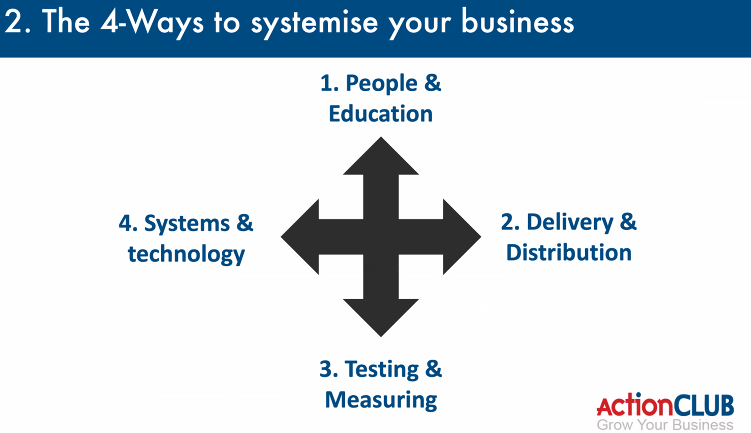What is leverage?
Today’s session with one of the ActionCLUB groups was how to systemise your business so that it doesn’t rely on you, the owner. So many business owners fail to put systems in place, which mean that they are eternally locked in the mindset of having to be “On The Tools” all day, every day. The concept of “leverage” means achieving more with less – putting effort into empower systems that will achieve what you are doing yourself, but without your personal effort. It is often represented by the image of a lever, as exemplified by Archimedes’ quote, “Give me a lever long enough, and a fulcrum on which to place it, and I shall move the world.” One way to achieve leverage is through the SYSTEM (Save Your Self Time Energy and Money) approach. Saving just 10 minutes a day can add up to 43 hours saved over the course of a year, while saving an hour a day could add up to 6 weeks saved per year… that’s an enormous impact on your personally, being able to reward yourself with time off; or it is time that can be reinvested into the business, taking it even further and scaling up at increased pace.
A business can achieve leverage by investing time in training someone else to take on tasks, thereby freeing up the business owner’s time and minimizing mistakes. The goal is to establish processes that become “Business As Usual” (BAU), making the business a commercial, profitable enterprise that can function with or without the owner’s direct involvement. This can be compared to the concept of writing a book, where the work is done once, but the author continues to receive rewards each time someone buys a copy. Whereas a business owner might look at a leaflet drop campaign as a one-off idea to get more sales, once a single one has been completed and documented, it can be converted into a system upon which the business runs and continues to grow.
How can this apply to your business? Find out a little bit below – although we admit this comes with a few caveats. Number 1 is to guard against the feeling of overwhelm: this is a massive part of running a business and can’t be achieved overnight. Full systematisation can take years, and even then, will need constant refreshing. Number 2 is that we can’t cover it all in this article. This is a very basic introduction, with a view to having a conversation with you about how we – with the ActionCOACH methodology – can help your business stop being limited by you and how much time you can give to it.
Where does systemisation fit into the life of a business?
The first two steps in the ActionCOACH programme are that of Mastery (where you determine whether your business is commercial, and generates something that people will pay for), followed by the Niche stage (where you get your sales and marketing set up to ensure a consistent stream of leads and conversions to customers). So leverage (systemisation of your business) is the third of these steps, where you create a far more efficient business for yourself, and one that can not only be scaled to a larger size, but also operates successfully whether you are there or not.
“Production vs Production Capability” refers to the difference between working in your business and working on your business. Henry Ford‘s approach to building his car factory was to design and build it so that it could run without him, which required a significant upfront investment and ongoing attention to ensure the production capability was optimized. The Land Rover factory allows customers to pay to follow the entire production process for their car, emphasizing the importance of transparency in production, across an 8-mile walk on the factory floor itself!
The majority of people in the UK are employees – 96% – with only a small percentage (4%) owning their own business. However, many business owners are still trading their time for money, which means they are effectively self-employed with the added responsibility of being the boss (although for solopreneurs, they are only a boss for themselves). Leverage is the key to moving beyond this model, as it allows for a scalable and more passive income. However, achieving a truly passive income requires a deliberate focus on building production capability and developing systems that can run without constant input from the business owner.
Why not watch the movie “The Founder” to learn how Ray Kroc systemized McDonald’s (with a caution to ignore how he treated his first wife). One scene in the movie demonstrates the creation of the most efficient kitchen possible, mimicked on a tennis court. Today, the average revenue for each McDonald’s restaurant in the UK is £2.2m, with a profit margin of £450k per year, and the average franchise owner works around 4 days per year. Think about that: in excess of £100k per day worked in the year, employing and training young staff (the average age for a McDonald’s manager is around 24 years old) to follow a system and a process.
4 ways to systemise your business
The vision and mission/culture statements are crucial for leverage because they inform recruitment, which is essential for building a team that shares the company’s values and goals. Getting the right people on board is crucial for delegation and scaling the business. When creating an organizational chart, it’s helpful to put oneself in every box first to identify areas for delegation and develop a default diary for new team members.

People often massively overlook the first one here, the people and education systems in your business. However, just getting someone / anyone on board and work it out along the way is quite often the undoing of many a business owner. This is such a critical part of business growth to get right. The people you bring on board, and the way in which you train and induct them into your systems and processes is a vital component of successfully scaling up.
For delivery and distribution, you need to look at how your product or service is made and arrives at the customer – granted, this will be markedly different depending on whether you are delivering a physical product (with actual question marks about when, where, how the product will reach the doorstep of a customer, and delivered by who) to a service (where the product may involve a digital process that needs completion by a certain time. It will also differ for B2C and B2B businesses – but it still needs to be part of your documented and recorded processes for operations.
Yes, testing and measuring is crucial for systemizing any business because it allows you to evaluate the effectiveness of your systems and make adjustments as necessary. By measuring key metrics, you can identify areas of your business that need improvement, and make data-driven decisions to optimize your processes. This helps to ensure that your systems are efficient and effective, which is essential for sustainable growth and success.
Where do I start to systemise my business?!
Before we even think about this, be conscious of your current state of mind. Are you feeling a sense of overwhelm? If so, step back for a moment and recall the metaphor of eating an elephant. You could make a start on this today, but realistically it’s likely you’ll only get part-way through documenting a single process in your business.
When systemizing a business, it’s important to focus on the processes that are most important or have the greatest impact. This includes processes that are followed most often, take the most time, or go wrong most frequently. It can also be helpful to establish routines and guidelines for meetings and overall organizational operations, such as clear “Rules of the game” that outline how things are done. By prioritizing and systemizing these key processes, a business can become more efficient, effective, and scalable.
Technology can be a great asset in systemizing your business and streamlining processes. Regular maintenance of equipment can prevent downtime and costly repairs. Integrating finance systems with live bank feeds and using cloud-based storage can also save time and reduce errors. Electronic receipt systems can also help with bookkeeping and expense management.

One easy way to start is by using a website like www.checklist.com to create checklists for different tasks and assign them to different people within your organization. You can also attach documents and guides to the checklists to help your team complete the tasks. Another tool to consider is Visio, which comes with Office 365 and can be used to create visual flowcharts of your processes. This helps to document what should be happening in different scenarios and provides clarity for your team. Without clear processes, important information may be stuck in your head or your team may not know what the next step is in a given situation.
What now?
All this being said without barely scratching the surface of how to systemise your business, it must be said that we are open to talking about any and all of this at any time. Andrew De Groot, our Head Coach and MD, is available for a complimentary coaching session – get in touch with Andi Davies to set it up.






